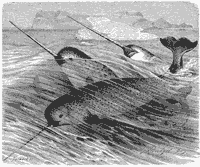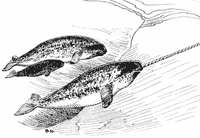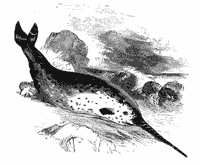|

 Unicorn whale: The most conspicuous characteristic of male narwhals is their single extraordinarily long tusk, which is a tooth that projects from the left side of the upper jaw and forms a left-handed helix. The tusk can be up to 3 m (nearly 10 ft) long (compared with a body length of 4–5 m [13–16 ft]) and weigh up to 10 kg (22 lb). One in 500 males has two tusks, which occurs when the right tooth, normally small, also grows out. Rarely, a female narwhal may also produce a tusk. Unicorn whale: The most conspicuous characteristic of male narwhals is their single extraordinarily long tusk, which is a tooth that projects from the left side of the upper jaw and forms a left-handed helix. The tusk can be up to 3 m (nearly 10 ft) long (compared with a body length of 4–5 m [13–16 ft]) and weigh up to 10 kg (22 lb). One in 500 males has two tusks, which occurs when the right tooth, normally small, also grows out. Rarely, a female narwhal may also produce a tusk.
Why a tusk? The purpose of the tusk has been the subject of much debate. Early scientific theories supposed that the tusk was used to pierce the ice covering of the narwhal's Arctic Sea habitat. Others suggested the tusk was used in echolocation. More recently, scientists believed the tusk is primarily used for showmanship and for dominance: males with larger tusks are more likely to successfully attract a mate.  This hypothesis was suggested by the activity of "tusking", in which two males rub their tusks together. This hypothesis was suggested by the activity of "tusking", in which two males rub their tusks together.
Tusk thermometer, barometer...However, recent work by a research team led by Martin T. Nweeia suggests that the tusk may in fact be a sensory organ. Electron micrographs of tusks revealed millions of tiny, deep tubules extending from the tusk's surface, apparently connecting to the narwhal's nervous system. While such tubules are present in the teeth of many species, they do not typically extend to the surface of healthy teeth. The exact sensory purpose of the tusk remains unknown, but scientists now hypothesize that it may detect temperature, salinity, pressure, and/or particulate  makeup of the water in which the narwhal swims. makeup of the water in which the narwhal swims.
Do not break! Like the tusks of elephants, narwhal tusks do not regrow if they break off.
Family Narwhal: Male narwhals weigh up to 1,450 kilograms, the female around 900 kilograms. Most of the body is pale with brown speckles in color, though the neck, head and edges of the flippers and fluke are nearly black. Older animals are usually more brightly colored than younger animals.

Quick and active: Narwhales are quick, active mammals which feed mainly on species of cod that reside under ice-enclosed seas. In some areas their diet seems to have adapted to include squid, shrimp, and various fish, such as schooling pelagic fish, halibut, and redfish. Narwhals normally congregate in groups of about five to ten. Sometimes several of these groups might come together, particularly in summer when they congregate on the same coast. At times, male narwhales rub their tusks together in an activity called "tusking". Recent findings of a marine mammal researcher at the Smithsonian Institution, finding that the tusk also plays a role in the animal's sensory perception, with as many as 10 million tiny nerves present within the modified tooth, suggests that the tusking may simply be a way of clearing encrustations from the sensory tubules, sort of like brushing teeth.
Deep divers: Narwhals are deep divers. During a typical deep dive the animal will descend at two meters per second for eight to ten minutes, reaching a depth of up to 1000 m, spend perhaps a couple of minutes at depth before returning to the surface. The deepest recorded is 1164 m. Typical dive times are 20 minutes, with 25 minutes recorded in exceptional cases.

 Harpoon+woman=Narwhal: In Inuit legend, the narwhal was created when a woman holding onto a harpoon had been pulled into the ocean and twisted around the harpoon. The submerged woman was wrapped around a beluga whale on the other end of the harpoon, and that is how the narwhal was created. Harpoon+woman=Narwhal: In Inuit legend, the narwhal was created when a woman holding onto a harpoon had been pulled into the ocean and twisted around the harpoon. The submerged woman was wrapped around a beluga whale on the other end of the harpoon, and that is how the narwhal was created.
Unicorn horns: Some medieval Europeans believed narwhal tusks to be the horns from the legendary unicorn. As these tusks were considered to have magic powers, Vikings and other northern traders were able to sell them f or many times their weight in gold. The horns were used to make cups that were thought to negate any poison that may have been slipped into the drink. During the 16th century, Queen Elizabeth received a narwhal tusk for £10,000 - the cost of a castle, which she used as a scepter. or many times their weight in gold. The horns were used to make cups that were thought to negate any poison that may have been slipped into the drink. During the 16th century, Queen Elizabeth received a narwhal tusk for £10,000 - the cost of a castle, which she used as a scepter.
Unicorns are often depicted with horns with a spiral pattern markedly similar to the narwhal's tusk.
 The truth of the tusk's origin developed gradually during the Age of Exploration, as explorers and naturalists began to visit Arctic regions themselves. In 1555, Olaus Magnus published a drawing of a fish-like creature with a horn on its forehead, while in 1577, Martin Frobisher depicted the horn going forward. The definitive end to the legend came in 1638, when Danish zoologist Ole Wurm gave a public lecture on the narwhal's tusks. The truth of the tusk's origin developed gradually during the Age of Exploration, as explorers and naturalists began to visit Arctic regions themselves. In 1555, Olaus Magnus published a drawing of a fish-like creature with a horn on its forehead, while in 1577, Martin Frobisher depicted the horn going forward. The definitive end to the legend came in 1638, when Danish zoologist Ole Wurm gave a public lecture on the narwhal's tusks.
All text is available under the terms
of the GNU Free Documentation License
|